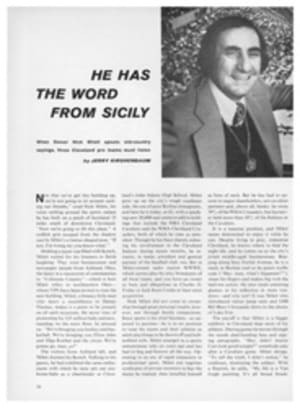
Here today, gold tomorrow
It is too early for more than a feeble ray of hope, but there is a growing possibility that the U.S. Alpine ski team may be on the brink of something more than oblivion for the first time in many a snow. Let us be restrained—even skeptical—for false optimism and undelivered dreams have been for several years the hallmark of American ski racers. Freshest in memory is the wreckage of last winter when the U.S. was rudely trounced in the FIS World Championships at St. Moritz, finishing behind almost every nation on earth, including dainty little Liechtenstein.
At that point the U.S. coaching staff had disintegrated once again, the team's leading racers (notably, three of the four Cochran children) were about to quit and both morale and talent seemed at a new low even for a team that had for years labored in mediocrity.
Yet now, like some frail phoenix, the U.S. ski team seems about to rise out of its own ashes. At the moment the primary source of American potential lies in the person of a strong, handsome blonde named Cindy Nelson. Born on the frozen shore of Minnesota's Lake Superior 19 years ago, she has determined Nordic good looks and the aggressive, even arrogant, style of hell-bent skiing that marks her as one of the two or three best women skiers in the world.
Nelson's specialty is the downhill, the most dangerous of Alpine disciplines, and there she comes smack up against the queen racer of them all, Austria's Annemarie Moser-Proell. This grim and powerful young lady, not yet 22, has dominated not only the downhill but the overall World Cup title for the past four years. And even today, with her newly svelte hourglass figure—having lost unknown and perhaps uncountable pounds in the past year—she is far ahead of the merely mortal women who compete against her. Already Annemarie has all but clinched her fifth consecutive World Cup title and early this month performed one of the more explosive feats in world skiing by winning three races—a downhill, a slalom and a giant slalom—in three days.
Still, it is Cindy Nelson of Lutsen, Minn., not one of the seemingly endless crowd of Austrian fr√§uleins, who is rocketing along on Mrs. Moser-Proell's ski-tails. A year ago this month Cindy won the downhill at Grindelwald, Switzerland, the first defeat for Annemarie after 11 consecutive downhill victories. And just before Christmas it was Cindy who streaked to first place in a downhill at Saalbach, Austria. These two downhill victories—first in World Cup history by any American, man or woman—have elevated the lithe blonde to the top rank of world-class skiers. And besides the win at Saalbach, this season Cindy has finished second and fourth in downhills and sixth in a giant slalom, up till now her weakest event. She has bombed off to a total of 88 World Cup points, leaving her second only to Moser-Proell in downhill and a creditable fifth in the overall standings. With the season less than half over, her scoring pace is nearly double that of any U.S. woman over the past five years.
Annemarie, who seems to have developed a gracious new personality to go with her sleek look, says of Cindy, "She is a very nice person and a very sound skier. When the piste is hard she will win again and again. She is very young and she is very hard on herself in her training. I think she may be as good as I have been in the downhill very soon. Perhaps already she is that good. In the years ahead Cindy Nelson may dominate the downhill as I have."
The U.S. Alpine director, Hank Tauber, says, "Cindy is the first American woman I have seen who has the potential to be a superstar. She has all the ingredients to be the best in the world. She has had a meteoric rise to where she is, and we shouldn't expect too much right away. Cindy had never even won a single World Cup point until last season, and now after her brilliant start this year we have to let the snow settle a little around her. It isn't fair to expect her to be consistently great so soon."
Last week there was a bit of snow settling. Starting as the first racer on a soft, flat downhill course in Schruns, Austria, Cindy was forced to plow snow through the entire run, a disadvantage that cost her a full second or more and left her in 16th place for the day. She also was suffering from a persistent cold and lingering headache. Still, she was unperturbed when discussing her poor showing. "Today there was no way I could have won starting first on a course this warm," she said. "But this season I really pride myself on being mentally prepared, and by that I mean that I look at things with a logical, optimistic reality. This was an exceptionally bad day, and I will just have to forget about it. I've never had more confidence in myself than I do now. I think I'm the best technical downhill racer in the world among the women. I really believe that. Of course, Proell is the best woman racer we've ever seen. Or maybe will ever see. She has everything. She is strong and she has desire and great equipment. She can go off like a bomb anytime. No one will be better than Proell."
Cindy Nelson's rise to stardom has not been easy. In December 1971, when she was first with the U.S. "A" team, she did well enough (12th and 13th) in a couple of early downhills, then dislocated her hip and missed the Sapporo Olympics. The following year, recuperating, she did not race in Europe at all, and even last year, except for her surprise downhill triumph, she was not really at her peak, although she did finish fourth in the world in downhill. This season was different from the start. "I've made up my mind I can win the World Cup," Cindy says. "For the first time since I was 10 years old I've got a coach I respect. I'm in better condition this year than I've ever been. I'm trying to be logical about my racing and about my life and, logically speaking, I think I could even win the World Cup this year."
Mrs. Moser-Proell seems to have a lock on the cup, Cindy's logic notwithstanding. What's most illogical about Cindy Nelson is that she has come to be a downhiller at all. At tiny Lutsen, 100 miles up the lake from Duluth, the training ground for downhillers is not a whole lot steeper than a parking lot. Cindy's parents run a neat but tiny resort and ski area with a vertical drop of just over 700 feet. There is scarcely space for a respectable slalom run. Yet Cindy began skiing before she was three, was given years of racer training as a child and now, grown to 5'6" and 140 pounds, she is certainly on the verge of something big.
For the first time since 1970, when Billy Kidd won an FIS gold medal at Val Gardena, there are signs that the American men's team also is about to produce top skiers. Already this season two young American unknowns, Geoff Bruce, 22, of Corning, N.Y. and Greg Jones, 21, of Tahoe City, Calif., have performed surprisingly well. Bruce finished fourth in a slalom at Madonna di Campiglio. Jones, starting in 37th place for the giant slalom at Madonna, slammed through two startling runs to come out of the pack and finish second. There have been other impressive performances among U.S. men starting far down in the crowd. Four Americans were in the top 15 downhill finishers at Garmisch, and the U.S. men have already gained more World Cup points in the first six weeks of the season than they totaled all last year.
Tauber says, "We count this year as a learning experience, but we're already way ahead of expectations in our results. We think we've got a stable organization this year, there aren't the conflicts on the team there have been in the past and, most important, we've come to the World Cup circuit this year with a whole different philosophy. We consider this a professional sport, and by that I mean that we are here to produce winners just as a professional team is supposed to win. We are not here to carry around a bunch of kids simply representing the good old U.S. in Europe. They are here to win."
PHOTO

